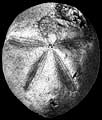The Echinoid Directory
Hernandezaster Sanchez Roig, 1949, p. 212
| Diagnostic Features |
|
|---|---|
| Distribution | Miocene, Cuba. |
| Name gender | masculine |
| Type | Hernandezaster hernandezi Sanchez Roig, 1949, p. 212, by original designation. |
| Species Included | Only the type species. |
| Classification and/or Status |
|
| Remarks |
|



